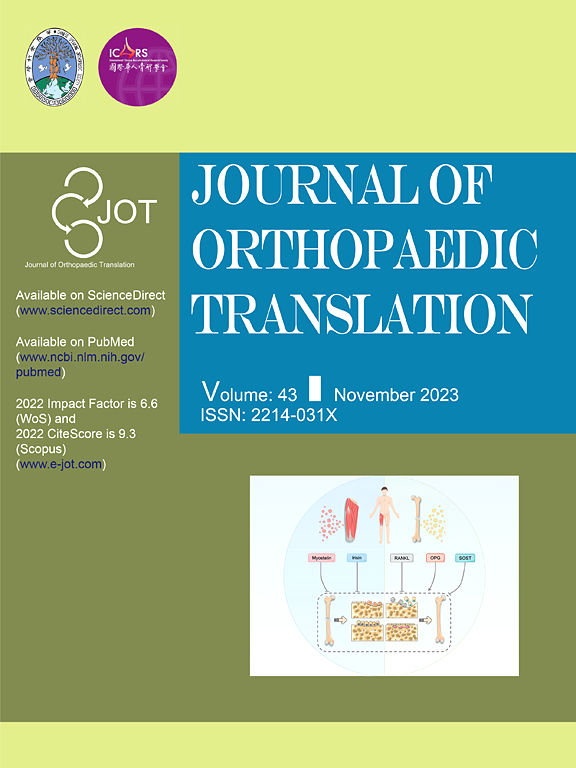Mesoporous bioactive glass-enhanced MSC-derived exosomes promote bone regeneration and immunomodulation in vitro and in vivo
IF 5.9
1区 医学
Q1 ORTHOPEDICS
引用次数: 0
Abstract
Background
Exosomes produced by mesenchymal stem cells (MSCs) have vascular generative properties and are considered new effective candidates for the treatment of bone defects as alternatives to cell therapy. Improving the pro-regenerative function and efficacy of exosomes has been a popular research topic in the field of orthopaedics.
Methods
We prepared mesoporous bioactive glass (mBG) microspheres via the template method. The ionic products of mBGs used to treat MSCs were extracted, and the effects of exosomes secreted by MSCs on osteoblast (OB) and macrophage (MP) behaviour and bone defect repair were observed in vivo (Micro-CT, H&E, Masson, and immunofluorescence staining for BMP2, COL1, VEGF, CD31, CD163, and iNOS).
Results
The mBG spheres were successfully prepared, and the Exo-mBG were isolated and extracted. Compared with those in the blank and Exo-Con groups, the proliferation and osteogenic differentiation of OBs in the Exo-mBG group were significantly greater. For example, on Day 7, OPN gene expression in the Ctrl-Exo group was 3.97 and 2.83 times greater than that in the blank and Exo-mBG groups, respectively. In a cranial defect rat model, Exo-mBG promoted bone tissue healing and angiogenesis, increased M2 macrophage polarisation and inhibited M1 macrophage polarisation, as verified by micro-CT, H&E staining, Masson staining and immunofluorescence staining. These effects may be due to the combination of a higher silicon concentration and a higher calcium-to-phosphorus ratio in the mBG ionic products.
Conclusion
This study provides insights for the application of exosomes in cell-free therapy and a new scientific basis and technical approach for the utilisation of MSC-derived exosomes in bone defect repair.
The translational potential of this article
Our study demonstrated that exosomes produced by mBG-stimulated MSCs have excellent in vitro and in vivo bone-enabling and immunomodulatory functions and provides insights into the use of exosomes in clinical cell-free therapies.

介孔生物活性玻璃增强间充质干细胞衍生外泌体在体外和体内促进骨再生和免疫调节
背景间充质干细胞(MSCs)产生的外泌体具有血管生成特性,被认为是替代细胞疗法治疗骨缺损的新有效候选物质。方法我们通过模板法制备了介孔生物活性玻璃(mBG)微球。结果成功制备了mBG微球,并分离提取了Exo-mBG。与空白组和 Exo-Con 组相比,Exo-mBG 组 OB 的增殖和成骨分化能力明显更强。例如,在第 7 天,Ctrl-Exo 组的 OPN 基因表达量分别是空白组和 Exo-mBG 组的 3.97 倍和 2.83 倍。在颅骨缺损大鼠模型中,Exo-mBG 促进了骨组织愈合和血管生成,增加了 M2 巨噬细胞极化,抑制了 M1 巨噬细胞极化,这一点已通过显微 CT、H&E 染色、Masson 染色和免疫荧光染色得到验证。结论:这项研究为外泌体在无细胞疗法中的应用提供了启示,也为间充质干细胞外泌体在骨缺损修复中的应用提供了新的科学依据和技术方法。本文的转化潜力我们的研究表明,mBG刺激间充质干细胞产生的外泌体具有良好的体外和体内骨赋活和免疫调节功能,为外泌体在临床无细胞疗法中的应用提供了启示。
本文章由计算机程序翻译,如有差异,请以英文原文为准。
求助全文
约1分钟内获得全文
求助全文
来源期刊

Journal of Orthopaedic Translation
Medicine-Orthopedics and Sports Medicine
CiteScore
11.80
自引率
13.60%
发文量
91
审稿时长
29 days
期刊介绍:
The Journal of Orthopaedic Translation (JOT) is the official peer-reviewed, open access journal of the Chinese Speaking Orthopaedic Society (CSOS) and the International Chinese Musculoskeletal Research Society (ICMRS). It is published quarterly, in January, April, July and October, by Elsevier.
 求助内容:
求助内容: 应助结果提醒方式:
应助结果提醒方式:


